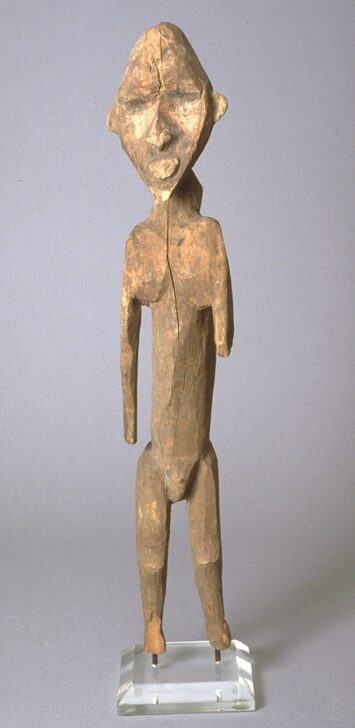Male Figure
Papua New Guinea (Kawari River)

Description
President's House object Summary
Papua/New Guinea is the largest island in the South Pacific. Art objects from the region have historically been valued by Western collectors for their anthropological and ethnographical significance, with most collecting occurring during the first half of he 20th century. European artists of the 1920's appreciated Oceanic art for its bold forms and patterns, making Oceanic art a catalyst to the rise of Surrealism and Expressionism.
The art of New Guinea has traditionally been produced for social and religious functions. Figures, a dominant motif throughout the South Pacific, are commonly crafted with a large head, elongated torso, and shortened limbs. They usually stand in unbalanced poses. Depicting individual culture heroes, creative divinities, ancestors, or water or wood deamons, male figures are placed in ceremonial houses to represent the warlike strength of male villagers, or considered to be inherited from mythical heroes who endowed them with their magical powers. The make figures that are usually kept in men's houses (Tambaran) are considered living beings with souls, and can also be important elements in hunting rituals. Figures owned by an individual can be moved to caves when the owner dies and become the physical presencee of an ancestors' disembodied existence.
The religious life of New Guinea has three core values: dynamism, the belief that every natural phenomenon is governed by an inner force of its own; ancestor worship; and highly structured rites and rituals. The culture is male-oriented, and artists are exclusively men. Metal tool have recently replaced the older art-making tools, such as volcanic stone, animal teeth, tusks and bone, and the decline of traditional culture has given rise to a mass production of art. Becuase of the structured religious life contemporary objects such as this work maintain a resemblance to more traditional art forms.
(Laura Zahodne)
Usage Rights:
If you are interested in using an image for a publication, please visit https://umma.umich.edu/request-image/ for more information and to fill out the online Image Rights and Reproductions Request Form.